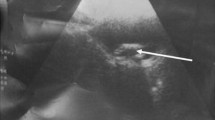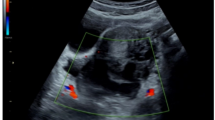Abstract
Intrauterine devices are a very effective form of contraception used worldwide for more than 2 centuries. One of the serious, but rare, complications of intrauterine contraception is perforation through the uterine wall into the pelvic or abdominal cavity. In this report we describe, persistent periumbilical discharge associated actinomycosis caused by migration of a copper intrauterine contraceptive device. To our knowledge, this is the first report of persistent periumbilical discharge caused by migration of a copper intrauterine contraceptive device. We recommend consideration of this minor possibility during evaluation of women with chronic abdominal discharge.




Similar content being viewed by others
References
Dennis J, Hampton N (2002) IUDs: which device? J Fam Plann Reprod Health Care 28:61–68
Andersson K, Ryde-Blomqvist E, Lindell K, Odlind V, Milsom I (1998) Perforations with intrauterine devices. Report from a Swedish survey. Contraception 57:251–255
Ozcelik B, Serin IS, Basbug M, Aygen E, Ekmekcioglu O (2003) Differential diagnosis of intra-uterine device migrating to bladder using radiographic image of calculus formation and review of literature. Eur J Obstet Gynecol Reprod Biol 108:94–96
Tuncay YA, Tuncay E, Guzin K, Ozturk D, Omurcan C, Yucel N (2004) Transuterine migration as a complication of intrauterine contraceptive devices: six case reports. Eur J Contracept Reprod Health Care 9:194–200
Caliskan E, Ozturk N, Dilbaz BO, Dilbaz S (2003) Analysis of risk factors associated with uterine perforation by intrauterine devices. Eur J Contracept Reprod Health Care 8:150–155
Russo TA (2005) Agents of actinomycosis. In: Mandell GL, Bennett JE, Dolin R (eds) Principles and practice of infectious diseases, 6th edn. Churchill Livingstone, Philadelphia, pp 2924–2934
Smith AJ, Hall V, Thakker B, Gemmell CG (2005) Antimicrobial susceptibility testing of Actinomyces species with 12 antimicrobial agents. J Antimicrob Chemother 56:407–409
Markovitch O, Klein Z, Gidoni Y, Holzinger M, Beyth Y (2002) Extrauterine mislocated IUD: is surgical removal mandatory? Contraception 66:105–108
Ozdemir H, Mahmutyazicioğlu K, Tanriverdi HA, Gündoğdu S, Savranlar A, Ozer T (2004) Migration of an intrauterine contraceptive device to the ovary. J Clin Ultrasound 32(2):91–94
Author information
Authors and Affiliations
Corresponding author
Rights and permissions
About this article
Cite this article
Polat, I., Gungorduk, K., Polat, G. et al. Persistent subumbilical discharge associated with actinomycosis caused by intrauterine contraceptive device: a case report. Arch Gynecol Obstet 277, 457–460 (2008). https://doi.org/10.1007/s00404-007-0477-3
Received:
Accepted:
Published:
Issue Date:
DOI: https://doi.org/10.1007/s00404-007-0477-3




